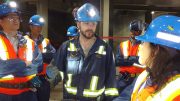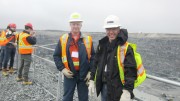Talk of platinum and palladium often leads North American mining investors’ minds to such far off places as South Africa, Russia and Zimbabwe.
But Pacific North West Capital (PFN-T) wants to bring their attention a little closer to home.
The company is in the midst of an aggressive drill program at its River Valley project, which sits 60 km northeast of here.
And while PFN isn’t exactly a trailblazer when it comes to exploring for the metals in Ontario, it is a key part of a fledgling trend in a province better known for its nickel and gold mines.
North American Palladium‘s (pdl-t, pal-x) Lac des Îles mine northwest of Thunder Bay and Stillwater Mining‘s (SWC.U-T, SWC-N) Marathon project attest to the province’s strong platinum group metals (PGMs) potential.
Magma Metals (MMW-T) also has the Thunder Bay North advanced-stage exploration project, with indicated resources of 9.5 million tonnes grading 2.3 grams platinum equivalent for 695,000 oz. platinum equivalent.
PFN, however, is banking on an entirely different geological formation, known as the River Valley intrusive, to vault it into the same category as its counterparts.
The intrusion covers 200 km within the Grenville Front tectonic zone – a 900-metre-thick, mafic, sulphide-poor layered intrusion.
With the rights to 80% of the River Valley intrusion locked up, PFN is the dominant player on the formation, with its only neighbours being Mustang Minerals (MUM-V) and Impala Platinum Holdings (IMP-J), two companies that are joint-ventured south of PFN.
The River Valley project hosts three main mineralized areas, all of which contain PGMs, gold and small amounts of copper and nickel that would count as credits at any future mine.
The company has divided the property into Dana Lake, Lismer’s Ridge and Azen Creek.
Dana Lake is further broken up between the Dana North and Dana South zones, while Lismer’s Ridge holds the Lismer’s Ridge zone and the Lismer North zone.
Using a cut-off grade of 1 gram platinum and palladium, the two Danas, Lismer Ridge, Lismer North, and a fifth zone, known as Varley, have a 19.3-million-tonne combined measured and indicated resource grading 1.64 grams palladium, platinum and gold.
The zones have a 881,000-tonne inferred resource grading 1.821 grams platinum and palladium.
While the resource comes from five zones, the mineralized area stretches over a 9-km strike length and comprises seven zones.
The Dana Lake area, which lies within a north-trending portion of the River Valley intrusion, makes up the largest portion of the measured and indicated resources, and is the current focus of the company’s exploration program.
The intrusion at Dana is an up-thrusted and rotated offshoot of the main intrusive body. The latest drill results there expanded known mineralization with highlight intercepts of 2.16 grams platinum, palladium and gold over 27 metres, and 2.6 grams platinum, palladium and gold over 30 metres.
PFN also reported that a separate hole in the area returned 2.05 grams rhodium over 2 metres.
The rhodium assay dovetails nicely with results released at the beginning of August, which found the metal in the first 11 holes of its drill program at Dana North.
Taken together, the results confirm PFN’s geochemical study on the project, which estimated rhodium concentrations at 10% of the deposit’s platinum grades.
This is significant news, because rhodium is rare and plays a crucial role as a hardener for platinum and palladium, making it highly valued in catalytic converters and jewellery.
While rhodium wasn’t included in the deposit’s last resource estimate, Harry Barr, PFN’s chairman and chief executive, says it will go into next March’s resource estimate.
In the months leading to the resource update, PFN will keep the drills turning. It is in the midst of a $5-million, 15,500-metre diamond drill program at the property. The drilling is fully funded, and will be guided by a key new addition to the PFN team.
On Sept. 7, the company announced that William Stone would serve as president. Stone, who has a PhD in geology, is one of the foremost experts on PGM projects in Ontario, and has served as vice-president of exploration for Magma and North American Palladium.
Getting Stone on the team furthers Barr’s reputation for bringing in top talent.
One of PFN’s major strengths is the deep well of expertise it gains from Barr’s ability to build a group of companies under one banner.
Pacific North West is part of the International Metals Group, which includes Fire River Gold (FAU-V), El Nino Ventures (ELN-V) and Next Gen Metals (N-V).
By constructing a host of companies instead of one individual company, the group spreads risk while benefiting from shared costs, resources and expertise – with technical teams, engineers, corporate financiers and management all sharing in the mission to develop a project portfolio.
Group members also collaborate to find joint-venture partners on early-stage exploration projects.
Barr’s philosophy is that by joint-venturing with larger companies, a junior gains both dollars and a different way of looking at a project, which often bears significant fruit.
The philosophy is responsible for bringing River Valley to its current status – although it was a bit of a winding road.
Kennco Explorations performed the earliest-recorded work at the property in 1968, including an airborne electromagnetic survey over the Janes, Davis, Henry and Dana townships.
The early efforts were thwarted in 1973 when the provincial government placed a group of townships, and River Valley along with them, into the Temagami Land Caution area. Any resource activity in the area was prohibited until 1996.
The move left River Valley abandoned before anyone thought to explore its PGM potential.
PFN acquired the land at the beginning of 1999, for the paltry sum of 600,000 shares and $265,000 in cash with payment over four years. It also granted a 3% net smelter royalty royalty, but may buy back 2% for $2 million.
Just six months after acquiring the ground, the company shrewdly cut a deal with a subsidiary of Anglo Platinum (AMS-J) that would put Anglo on the hook for funding all exploration, up to a completed feasibility study.
From 1999 to 2007, Anglo spent over $22 million on the property, defining a resource and gaining information that has proven invaluable to PFN.
The taps were turned off, however, after the financial crisis of 2008, when Anglo told PFN that it wouldn’t be spending any more cash on the project.
That paved the way for PFN to buy back Anglo’s 50% interest for 8.1 million PFN shares, and warrants on another 3 million shares with a 30¢ strike. The deal was completed in April and gave Anglo 10.5% of PFN’s shares.
Anglo joins significant shareholders in PFN, including Stillwater Mining, which holds 7%, and Pinetree Capital, which holds 8%.
PFN launched a $1-million exploration program after closing the deal with Anglo. It represented the first drill program on the property since 2005, and has since expanded to the $5-million-level.
An updated resource estimate will be completed in March, and a preliminary economic assessment will come six months after that.
The current exploration program is using one drill rig on sections at 25-metre intervals through the 900-metre-long, north- to south-trending Dana Lake deposit. The area was previously drilled at 50-metre intervals.
The program will also test new drill targets found outside of the contact by a geophysics survey, and deeper targets that were generated to follow th
e footwall mineralization down dip.
While River Valley has considerable resources, PFN believes it has yet to hit the real motherlode.
A recent study of the geology indicates that known mineralization in the resource comes from another undiscovered source.
The River Valley resource is the result of sulphides rich in PGMs pulsing into the River Valley chamber.
The source of that platinum-rich magma has not yet been identified, but PFN’s senior geologist Ali Hassanallizadeh theorizes that it will lie at a deeper depth, and geophysical tests have produced some signatures that he is eager to test with the drill.
Bolstering the idea that more resources could be waiting for discovery at greater depths is the known geology in the area. Mines in the Sudbury basin typically go down to 2,250 metres, and North American Palladium’s Lac des Îles mine reaches 1,220 metres.
Whether or not a source for the current deposit is discovered, Barr is confident the company will bring the right metals to the market if a mine is erected at the site.
That confidence comes from platinum and palladium’s scarcity, and from their indispensible practical uses. Some 81 million oz. gold and 680 million oz. silver are mined worldwide every year, compared to 7 million oz. palladium and 7 million oz. platinum.
PFN shares have moved between 9¢ and 40¢ over the last 52-week period, and currently trade in the 25¢ range. The company has 94 million shares outstanding.






Be the first to comment on "Pacific North West looks to bolster Ontario’s PGM cred"